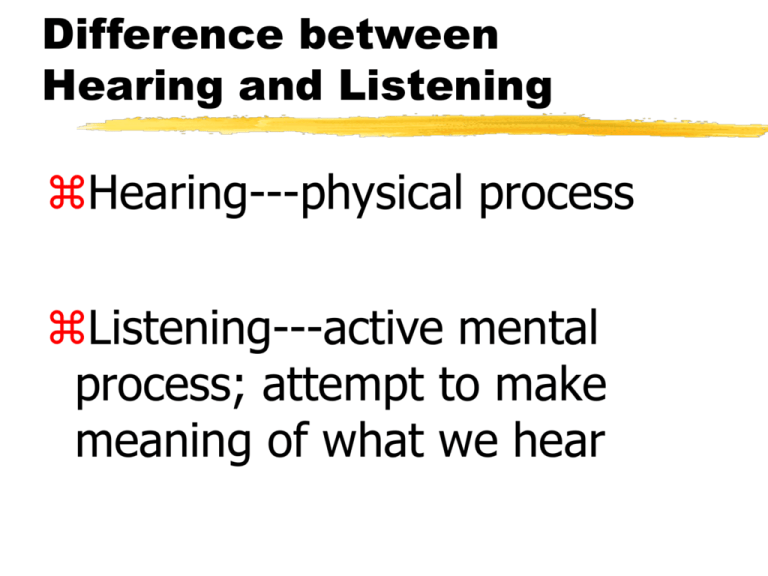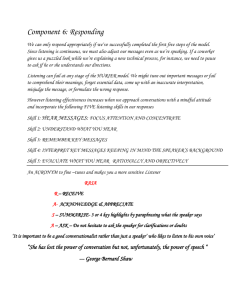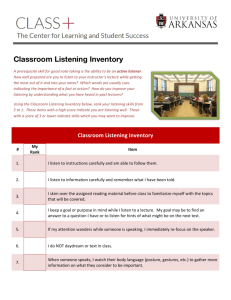Hearing vs. Listening
advertisement

Difference between Hearing and Listening Hearing---physical process Listening---active mental process; attempt to make meaning of what we hear Steps of Listening 1. Hearing---electrochemical impulses are transmitted to brain 2. Attending---what we decide to focus on based on our wants/needs Steps cont’d 3. Understanding---Making meaning of what is heard based on grammar and social context 4. Remembering---ability to recall information. People remember 1/2 of what they listen to immediately and 1/4 of info from 2 months ago. 3 Types of Listening 1. Informational used when dealing with facts gather as much accurate data as possible focus on factual details rather than criticism or judgment 3 Types of Listening 2. Evaluative purpose is evaluation and decisionmaking Informational listening MUST come before this Evaluate on basis of speaker’s credibility, use of evidence, and emotional appeal 3 Types of Listening 3. Empathic Focus on speaker’s emotions to provide emotional support in order to help speaker solve a problem or come to terms with a situation Intention is NOT to make decision for the speaker. Bad Habits (that interfere with effective listening) Pseudo listening Stage-Hogging Selective Listening Fill In Listening/Reconstructive Listening Insulated Listening Defensive Listening Ambushing Insensitive Listening Bad Habits (that interfere with effective listening) 1. Pseudolistening---acting like you are listening when your mind is elsewhere an imitation of the real thing - you know the type - smile, nod, add a few words while masking thoughts that have nothing to do with what is being said Self-Centered/Stage hogging--Rehearsing what you will say while speaker is speaking ---the stage-hogger is busy looking for ways to turn the topic of conversation to themselves instead of showing interest in the speaker Bad Habits (that interfere with effective listening) Selective---responding only to the parts of the speakers' remarks that interest them, rejecting everything else that is said Fill-in---gaps left in understanding by selective listening filled by what we expect to hear Reconstructive ---take a new message and rebuild it so it’s like a previous message. (Telephone Game) Defensive ---focus on ideas not even there and interpret as personal attacks when they were not intended that way this listener thinks the speaker is out to get them and reads into every word that is being said to try to decipher if they feel it is a personal insult Insulated ---choose not to listen to what we don’t want to hear the cold shoulder style - this listener fails to hear or acknowledge the speaker when they don't want to discuss a topic and the speaker starts talking about the subject anyway Ambushing--watch these type of listeners - they are listening but they are gathering information to use against you when you finish speaking Insensitive--- these type of listeners take the speakers' words at face value - they don't take into consideration the words not being spoken and behavior being exhibited that perhaps the speaker is communicating more than the words that are actually spoken






